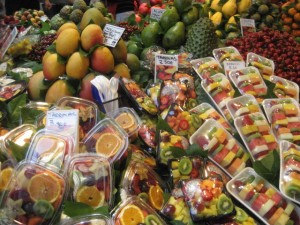Why I think health claims are about marketing, not health? Gerber’s whey claim
Yesterday’s New York Times displayed a full-page advertisement for Gerber baby food (owned by Nestlé, no relation):
Gerber is taking more than baby steps to reduce the risk of certain allergies
.…The FDA concludes that current scientific evidence is appropriate for consideration of a claim regarding the relationship between the consumption of 100% whey-protein partially hydrolyzed infant formula and reduced risk of atopic dermatitis.
….We’re proud to say that Gerber Good Start is the first and only formula brand made from 100% whey-protein partially hydrolyzed. In contrast, most other routine milk-based formulas are made with intact cow’s milk protein.
Translation: Some infants are allergic to the proteins (whey) in cow’s milk. Treating the proteins so they are split apart into smaller fragments (partial hydrolysis) apparently destroys some of their ability to elicit allergic immune reactions in the skin.
But here’s where the ad gets totally weird:
The FDA has concluded that the relationship between 100% whey-protein partially hydrolyzed infant formulas and the reduced risk of atopic dermatitis is uncertain, because there is little scientific evidence for the relationship. Partially hydrolyzed formulas should not be fed to infants who are allergic to milk or to infants with existing milk allergy symptoms.
Huh?
Blame Congress for this one. It insists that the FDA allow “qualified” health claims” for which scientific evidence is uncertain.
If you want to know why the FDA can’t seem to get anything done, take a look at what it’s staff had to do to respond to the Gerber petition. Graduate students take note: this is an exhaustive review of scientific studies on the relationship between hydrolyzed whey protein and infant skin allergies.
Here is the FDA’s conclusion, written in FDA-speak, about Gerber’s petition for a health claim:
In light of the above considerations, FDA intends to consider the exercise of its enforcement discretion for the following qualified health claims (my emphasis):
1. “Very little scientific evidence suggests that, for healthy infants who are not exclusively breastfed and who have a family history of allergy, feeding a 100% Whey-Protein Partially Hydrolyzed infant formula from birth up to 4 months of age instead of a formula containing intact cow’s milk proteins may reduce the risk of developing atopic dermatitis throughout the 1st year of life and up to 3 years of age.”
2. “Little scientific evidence suggests that, for healthy infants who are not exclusively breastfed and who have a family history of allergy, feeding a 100% Whey-Protein Partially Hydrolyzed infant formula from birth up to 4 months of age instead of a formula containing intact cow’s milk proteins may reduce the risk of developing atopic dermatitis throughout the 1st year of life.”
3. “For healthy infants who are not exclusively breastfed and who have a family history of allergy, feeding a 100% Whey-Protein Partially Hydrolyzed infant formula from birth up to 4 months of age instead of a formula containing intact cow’s milk proteins may reduce the risk of developing atopic dermatitis throughout the 1st year of life and up to 3 years of age. FDA has concluded that the relationship between 100% Whey-Protein Partially Hydrolyzed infant formulas and the reduced risk of atopic dermatitis is uncertain, because there is very little scientific evidence for the relationship.”
4. “For healthy infants who are not exclusively breastfed and who have a family history of allergy, feeding a 100% Whey-Protein Partially Hydrolyzed infant formula from birth up to 4 months of age instead of a formula containing intact cow’s milk proteins may reduce the risk of developing atopic dermatitis throughout the 1st year of life. FDA has concluded that the relationship between 100% Whey-Protein Partially Hydrolyzed infant formulas and the reduced risk of atopic dermatitis is uncertain, because there is little scientific evidence for the relationship.”
Why would Gerber’s place a hugely expensive full-page ad in national newspapers to celebrate a decision like this? Because it knows that any health claim, no matter how poorly substantiated by science, gives it a competitive advantage.
This is reason enough to promote breastfeeding.




